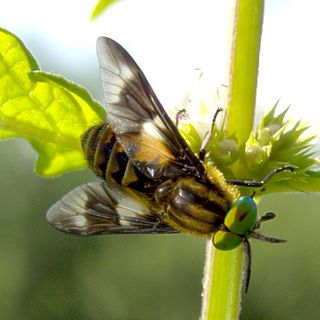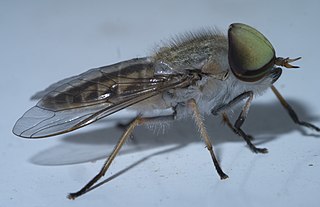
Horse-flies and deer flies are true flies in the family Tabanidae in the insect order Diptera. The adults are often large and agile in flight. Only female horseflies bite land vertebrates, including humans, to obtain blood. They prefer to fly in sunlight, avoiding dark and shady areas, and are inactive at night. They are found all over the world except for some islands and the polar regions. Both horse-flies and botflies (Oestridae) are sometimes referred to as gadflies.
Brennania is a genus of flies in family Tabanidae. It was originally known as Comops, created as a subgenus of Apatolestes by Brennan (1935). Philip (1941) then raised it to genus level, but renamed it to Brennania.

Stonemyia is a genus of flies in the family Tabanidae.

Apatolestes is a genus of horse flies.

Superfamily Tabanoidea are insects in the order Diptera.
Cornelius Becker Philip (1900–1987) was an American entomologist, noted for assigning comedic names to species he described.

Tabaninae is a subfamily in the family Tabanidae commonly known as horse flies. There are more than 3000 described species in Tabaninae.

Diachlorini is a tribe of horse flies in the family Tabanidae.
Chrysops surdus is a species of deer fly in the family Tabanidae.

Chrysopsinae is an insect subfamily in the family Tabanidae commonly known as deer flies or sheep flies and are bloodsucking insects considered pests to humans and cattle. They are large flies with large brightly-coloured compound eyes, and large clear wings with dark bands. They are larger than the common housefly and smaller than the horse-fly.

Tabanus americanus, the American horse fly, is a species of horse-fly in the family Tabanidae.

Tabanus molestus is a species of horse fly in the family Tabanidae.
Hybomitra hinei is a species of horse fly in the family Tabanidae. A male Hybomitra hinei wrighti has been recorded reaching speeds of up to 145 km (90 mi) per hour when pursuing a female.
Chrysops proclivis is a species of deer fly in the family Tabanidae.
Tabanus sagax is a species of horse fly in the family Tabanidae.

Tabanus punctifer, commonly known as the western horse fly, is a species of horse fly in the family Tabanidae. This species of horse fly is approximately 20.5 mm (0.8 in) long. They are typically found throughout the southern and western parts of the United States. They can be found between Utah and Mexico, and between California and Texas. The thorax is covered with long hairs that give it a creamy white color, while the abdomen is completely black. Much like other horse fly species, the Tabanus punctifer female requires a blood meal for the development of their eggs. Females will bite horses, livestock, and humans, making them vectors of disease for pathogens and parasites.

Pangoniinae is a subfamily of horse-flies in the order Diptera, containing at seven tribes and over 40 genera.

Scionini is a tribe of horse and deer flies in subfamily Pangoniinae of family Tabanidae.
Bolbodimyia is a genus of horse flies in the family Tabanidae.
Stibasoma is a genus of horse flies in the family Tabanidae.












